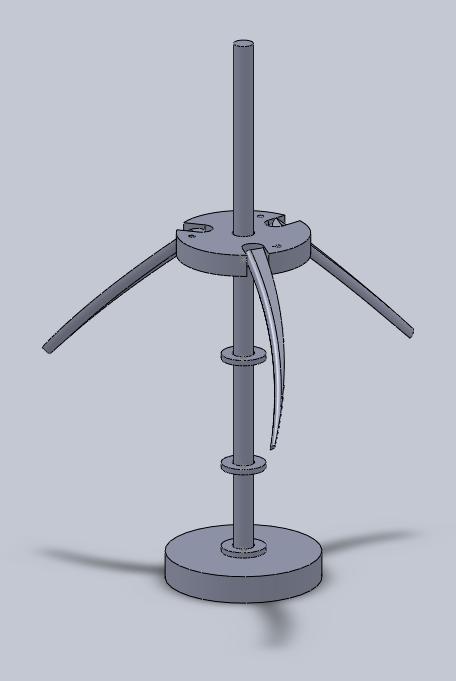Magnetic Parachuting Projectile Launcher


The Magnetic Parachuting Projectile Launcher is designed to be a fun way for kids to learn about the concepts of magnetism (both polarity and magic...), projectile kinematics, and drag. The object itself is a cylindrical base on which ring-magnets fit. If stacked with alternating polarities, they stack, levitating all but the bottom magnet along the pole. The flight piece (also with magnet inside) goes on the top, and can be compressed down and let go, allowing it to fly up into the air and then either (A) spin on the way down due to deployable blades, or (B) parachute its way down. Ideally it would also whistle on the way down for an overall more entertaining experience.
The Magnetic Parachuting Projectile Launcher started out as a very ambitious concept based on the simple idea that ring magnets stacked alternatingly on a pole can levitate in a controlled fashion.
Concept Changes: When looking at the rapid protyping processes, and thinking through each of the parts we would have to make, we realized that threading would be rather difficult, especially to get smooth, and minimize friction. So we dropped the idea of threading. Instead we needed another way to get the projectile to spin. The whistles were also dropped, as we just didn't know enough about how they could work. Iteration 2 replaced the up-down spinning rotors with rotors that would deploy at the peak of the projectile's flight (as it caught air), and cause the projectile to spin on the way down. Iteration 2 had the longest running time, and was only scrapped for Iteration 3 close to the end of the project.
Start-Build:
The first step was looking around for magnets. Magnets come in varying magnetic grades (N#-N###), shapes, and sizes. We found many of varying sizes and strengths, and wildly varying prices. Unfortunately most of the ideal ones were out of our price range. Our ideal magnets were $25 each. We found some relatively cheap magnets that were a size close to what we wanted, and ordered them. We didn't want to get caught up by time constraints. While the magnets were being ordered, we thought about the production of the blades and realized that we really didn't have a clever way to either FDM them and attach them, or use any other process to make them. The aerodynamics of it was daunting to say the least. Because of this inability to produce blades, we moved onto Iteration 3.
Concept Changes: Because we couldn't make blades, we ended up scrapping the idea of spinning entirely, we ended up deciding that as long as it's going up, and carrying a magnetic payload, it still needs to come down gracefully. Our solution was a parachute. We'd cut holes in the projectile to mount strings, and air-holes in the bottom so that at the peak the parachute balanced just above the part would catch air, and initiate the graceful descent.
Base Build: We started work on the base itself, we machined a solid large base out of machinist's plastic, and jammed a (non magnetic) rod into it of an appropriate diameter.
Magnets Arrive: When the magnets arrived we put them on and were severely disappointed by their "5.4 pounds" of repulsive force. We could mange to launch the top magnet off the pole, but only just barely, not nearly enough to launch our top off. We believe that the low jump height was caused by the attractive force between every other magnet. With time running short, ordering more magnets didn't seem feasable, and we had already spent what we considered our magnet budget.
Acrylic-Top (Projectile) Build: We wanted our top to include a magnet inside, so we made the SolidWorks part, split it into three (with each layer being 1/8" thick), exported into AutoCad, made the lines red and line thicknesses 0", and then exported again as a 2004 DXF. We then sent that to the laser cutter. The manufacturing of the part was incredible. We had the model turned into a real life thing in-front of our eyes. We left our pieces in the laser cutter for a few minutes to avoid the acrylic fumes that were created during the cut. We then had a bit of trouble glueing the three layers together. Apparently the magic solution that disolves acrylic so that it can fuse to itself, doesn't work on forged acrylic. Our solution was just a quick epoxy, and then a coat of spraypaint, since the epoxy caused an unwanted physical appearance.
Parachute: The parachute was a simple thing, however we should have reasearched them a bit more. It was cut out 1 layer of a flimsy-bag-like material, and had 5 strings attached to it, that would go into the slots in the projectile.
Assembly: Adding it all together, we saw what a prototype of our project really looked like. It failed to launch, or to parachute down from a small height. It was still fun to play with, and with parachute attached, and strings hanging down, looked like a jelly-fish, and could move like one too, by bouncing the magnets below it.
Carnegie Mellon University
March 2, 2010